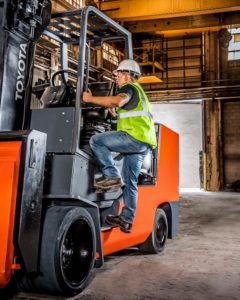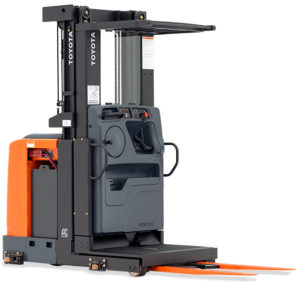
In the material handling industry, falling or tripping can turn out to be a lot more than just an embarrassing moment in front of co-workers and friends. Especially when forklifts are involved, it can lead to injury or, in worse cases, death. When we get focused on a task, sometimes we neglect to pay attention to our surroundings. Tripping hazards are all around us, so it is crucial to stay alert. Below is a shortlist of possible trip points to look out for when working with forklifts.
1. The steps on your forklift are used to enter and exit all day. Depending on the design of the forklift, tripping hazards will differ. You should always be aware of the height and location of each step. Also, look out for changes in elevation that can cause you to lose balance or get your foot caught. Use a 3 point stance when entering and exiting the forklift. Always have one foot down and grip part of the forklift with each hand for balance.

2. The accelerator, parking brake pedals, and service brakes should be kept in mind when entering and exiting a forklift. You should know their placement, whether they are on the floor or the pendulum. As a safety requirement, before exiting the forklift, make sure you engage the parking brake. This ensures that the foot-operated parking brake pedals are away.
3. The floorboard will usually vary in shape, size, and material. Always look out for changes in elevation and for abnormalities that might get your foot caught. If the tread wears off or the floorboard is damaged, replace them before operating the forklift. Improper installation can add more tripping hazards, so make sure everything is installed correctly before getting to work.
4. Forks and attachments like clamps or carpet poles on the front of a forklift usually create an elevation change at a low height that one can miss if not paying attention. Always look at the ground around you when walking around a forklift.
5. Optional equipment such as floor-mounted heaters and defrosters, audio speakers, floor stands, or mini-levers and amenity trays, can take up additional space in the compartment and can cause an operator to trip or fall if not aware of their location. Keep in mind where the optional equipment is located and based off any obstructions that are present, use the proper side when entering and exiting the forklift.
These general trip point tips are on and around forklifts. Forklifts are all designed differently, so pay attention to the points that may be present based upon your specific configuration. These points may seem obvious, but one should reinforce these principles because they can help you enhance forklift safety.
To learn more about Toyota Material Handling Solutions’ operator safety training or forklift safety tips, contact us today!
Request Info on Operator Safety Training
Tags: forklift safety training
